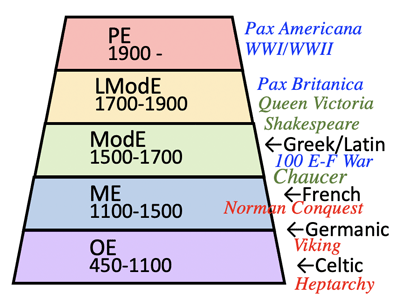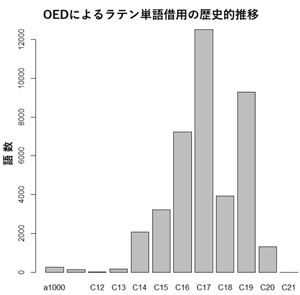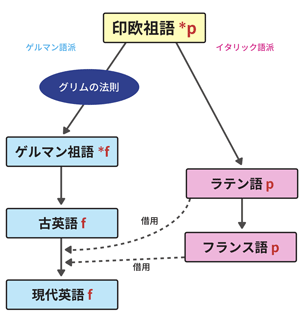$\frac{1}{2}$
History of English Language
Cat: LAN
Pub: 2016
#: 2404b
Ryuichi Hotta (堀田隆一)
24330u
Title
Ancient Japanese - English Vocabulary
古語・英語単語集
Index
Key
Esperanto
Remarks
>Top 0. 序文:
- 英語の変化を通時的 (共時的にではなく)に見る; 現在は一通過点に過ぎない。
- 千年前の過去から現在を経由して千年後の未来へ流れていく時間軸に沿って英語を観察する。
- 自分が生きている現在を過大評価しない。
- 現在の静止画観察と通時的な動画観察とを半々の重みで理解する。
0. Instroduction:
- View the changes in English diachronically (rather than synchronically)
- Observe English along the time line which flows from the past millenium through the present to the future millenium.
- Never overestimate the current state situation.
- Understand the current still state and diachronic video views eually.
>Top
1. 三単現の -s:
- 古英語では、三単現以外にも各々特別な語尾がついていたが、初期近代英語期にかけてすべて消滅したが、三単現の-sだけが例外的に生き残った。
- 英語の標準言語と非標準言語:
- 英語には標準と非標準(方言、変種)がある。非標準の英語は、民族、階級、性別、宗教、職業などによって変種とみなされる。
- 英国でも上流階級とロンドンの労働者階級中心のCockneyがあり、後者は特別な発音形式や語法を示している。
- 米国では黒人系、ユダヤ系の米語に特徴的な違いがある。
- 標準変種では、人称・数・時制・法の原理の組み合わせで語尾変化するが、非標準変種では、それに加えて主語と動詞が隣接しているか田舎、2つの動詞がandで結ばれているかどうかによっても決定される。
- 標準変種が"標準"となったのは、言語的に理由ではなく、社会的な影響力によるものである。
- アルファベットの歴史: フェニキア文字 (1700- 1000BC)
1. The third person's -s ending:
lufian=love
単数
複数
First person
lufie - love
lufiap - love
Second person
lufast - love
Third person
lufap - loves
- In OE, there were special endings in addition to the the third singular ending, bu all of them disappeared by the early ModE peiod, and only the third singular -s surviced as an exception.
- Standard Englsih and Non-standard English (dialects):
- Non-standard English is considered as a variant or a dialect unisquely used in each ethnicity, class, gender, religion, or occupation, etc.
- In UK, there is Cockney English mainly used in labor class in London, and in US unique English used in black or Jewish people.
>Top 2. 母音表記:
- 英語の母音要素:
- [iː, i, e, æ, ʌ, ɑː, ɒ, ɔː, u, uː, ɜː, ə, ei, ai, ɔi, əu, au, iə, eə, uə] 20母音
- 発音と綴字の乖離: 75-84%までは綴字規則に沿っている。但し、高頻度の上位400語については不規則な綴字が多い。
- 発音は相対的に革新性がり、綴字は相対的に保守性があるので、時間の経過と共に発音と綴字の乖離が拡大する傾向。
- 要因としては、OE時期に、ローマン・アルファベットを借用した。
- ME期の多様な綴字習慣が、現在まで生き残った
- ModE期に多く以後語源的綴字が生まれた
- ModEの時期に発音上の変化が生じた (大母音推移 Great Vowel Shift)
- 全時代を通じて、他言語から語意と独自の綴字を借用してきた。
- 母音と綴字の多対多の関係:
- gŏd (=god)とgōd (=good)はOEでは同じ綴り
- 借用した元のラテン語には母音の長短の区別がない。
- アルファベットの歴史:
- 1700-1000BC: 北部セム系フェニキア文字; 22子音字のみ。母音音素はあったが母音は綴字に表現しない。(ヘブライ語やアラビア語も子音のみ)
- 1000BC: ギリシア文字: 対応する音素がないために使われなかった A, E, I, O, Yをギリシア語の母音に流用。
(但し、母音を完璧に表現はできなかった。)
- 西ギリシア文字で、母音の長短の区別なし。
- 東ギリシア文字では[e] =E, [eː]=Ωで表現。
- 700BC: エトルリア文字: 西ギリシア文字をローマン・アルファベットに橋渡し
- 700BC: ローマン・アルファベット; 西ギリシア文字から少数の母音文字を継承
- 6C末 BC: ローマン・アルファベットをそのまま継承
- 21C PE: 多数の母音音素に対し、少数の母音文字で対処
- 文字体系は、すでに話し言葉を習得している者のために発展してきた。即ち、書き言葉は、対応する話し言葉は復元できるていどに反映すれば用を足すものとして発展。(綴字は母語話者にとって何とか機能していればよい。非母語話者には不親切・不合理に映る。)
2. Vowels and spelling:
- 印欧祖語: 4000BC -
- ゲルマン祖語: 1000BC -

- English has 20 vowels.
- Discrepancy and spelling in English: It is sadi taht 75-84% follow spelling rules. But the top 400 requent words tend to have irregular spellings.
- Vowels and spellings ha e many-to-many relationship.
- History of Alphabet:
- 1700--1000BC: Northern Semitic Phoenician script; only 22 consonants and no vowels.
- 1000BC: Greek letter; representing vowels by A, E, I, O, Y which were not used in Greek.
- 700BC: Etruscan alphabet
- 6C end: inherited the Roman alphabet.
- PE: expressing many vowel phonemes using limited number of vowel characters.
>Top 3. 英語と米語の差:
- 一般的イメージとしては、英国は伝統を尊び保守的、米国は変革を重んじ革新的。
- 英語の言語的変化は、17C以前の英国での英語だったので、英国英語は保守的であるという評価は的を得ていない。
- 英語と米語の差の典型例として
- autumn - fall
- railway - railroad
- bonnet - hood
- lift - elevator
- petro - gassoline
- hoover - vacuum clearner
- OE時代以前のゲルマン語文化は、夏と冬の2季節
- lencten (四旬節)が広義の春
- hærfest (収穫期)が広義の秋(harvest)
- ME時代になると、summerが夏+春となる。
- 春の到来: Sumer is icumen in. (=Summer has come in.)
も表現。
一方でspring (跳ねる)が登場
- 17C: 米国にautumnとfallの両方が移植。
- その後、英国ではautumn、米国ではfallが優勢 (autumnは形式語)
- Zの発音についても、17Cまでは英国でも[zed]が優勢。ModE初期に[zee]も登場。B,C,D,E,G,P,T,Vとの同じ韻
その後17C中に、米国に[zed][zee]も移植しがた、[zee]の方が優勢化
3. Differences of British & American Englishs:
春
夏
秋
冬
OE
lencten
sumer
hærfest
winter
ME
sumer
winter
ModE
spring
summer
autumn
fall
winter
- The general image is: British English is conservative, while American Egnlish is innovative.
- But the liguistic hange in Englished occurred in UK before 17C.; British English was changeable.
- Why autumn in UK and fall in US:
- Germanic culture before OE era had two seasons of summer and winter.
- In ME era, the concept of spring and autumn (also fall) is added.
- Prounciation of Z is different between Br. and Am.
>Top 4. ’any man alive’ 語順問題:
- any man alive (だれもかれも)
; any dead man; *any alive man (*この表現は許されない); any living man
- 同様の研究課題:
- alive [əláiv] とlive[liv], life[laif]の発音の違い
- an apple; *a apple
- five[fáiv] とfifth[fífθ]
- récord (n); recórd (v)
- alive ←on life[ən láif]; →[ə láif](nの消滅)→alife→alive
- in the →i'th' のようにnの消滅 (詩などでは)
- even/eve; maiden/maid; open/ope (nの消滅はよくある現象)
- abed, afire, aflame, afloat, afoot, aland, aright, asleep, asunder, abroadなども同様; 歴史的にはon →a-
- on lifeのように前置詞の後は与格をとる。
- さらに有声音に挟まれると無声音→有声音化
[f, θ, s] →[v, ð, z]
- on life→[on liːve]→on live→alive
- any man aliveの語順 (統語的振る舞い)は、aliveは形容詞であるが、歴史的に前置詞句であった時代の名残。
- 韻律的な理由: ány mán alíve の強弱パターンは[○●○●○●]; これが•ány alíve mánだと[○●●○○●]
- alíveのように[●○]の強勢パターンは、前置より後置の方が韻律的にはまりがよい。
- 前置詞onに由来するa +動詞ingの例: go a begging, go a-fishing, set a going; was a dying; was a building;
- 前置詞に支配された動名詞 or 進行形を構成する現在分詞系の両解釈がある。
- 言語はスクラム:
- onの音の変化、nの証明と母音の弱化という小さな変化が、大きなうねりとなって音韻形態、綴字、統語、韻律、語形成、語彙に影響を与える。
4. Word order of 'any man alive':
単数
複数
主格
līf
līf
対格
līf
līf
属格
līfes
līfa
与格
līfe
līfum
- Wor
>Top 5. 語彙の三層構造
- Help me!; •Aid me; *Assist me!
- 英語の本来語は、短く、平易、ぶっきらぼうだが、温かみがある
- フランス語起源の単語は、中立的、無色透明の語感
- ME〜ModEの時代: 特に16C〜17Cがラテン語借用のピーク;
ラテン・ギリシア語起源の単語は、他音節、高尚、学問的、文章語的
- 例: folk - people - population
- 1280: peopleがフランス語から借用
- folkの語感は、人々より民族に近い。古風で感傷的な語感
- 1600: populationは、ラテン語より借用; 通常は'人口'の意味; the white population 白人住民というように集合的な人々の意味。
5. Three layers of Vocabulary:

OE
French
La/Gr
ask
question
iterrogate
book
volume
text
fair
beautiful
attractive
fast
firm
secure
fear
terror
trepidation
fire
flame
conflagration
foe
enemy
adversary
folk
people
population
gift
present
donation
go
depart
exit
goodness
virtue
probity
guts
entrails
intestines
hearty
cordial
cardiac
help
aid
assistance
holy
sacred
consecrated
kingly
royal
regal
lively
vivacious
animated
rise
mount
ascend
time
age
epoch
word
term
lexeme
word-hoard
vocabulary
lexicon

- ラテン語借用の歴史: 断続的に借用。
- 5Cまで:アングロサクソンが大陸に居住していた頃、ローマ人との交易を通じて、butter, candle, cat, cheese, mile, peppeer, sack, street, tile, wineなど商業の語彙が流入
- 6C末まで: アングロサクソン人がブリテン島に移住後(5C)に、ガリア地域との交流によって、cock, Ltin, master, nun, pear, relicなど借用。
- 597: キリスト教化に伴い、宗教・学問関係用語流入: altar, creed, deacon (助祭), verse, grammar, offer, pope, psalm (賛美歌), sabbath (安息日), school (宗教学校)
- 1066 - 1500: イングランド知識人が、古典語・医学・天文学などを借用。client, conflict, equal, explanation, formal, include, item, library, picture, tradition
- 16C ルネサンス期: 聖書英訳の時代。新たな思想・学問・古典などの専門用語や文章語。allusion (言及), confidence dedicate, describe discreation, education, exaggerate, expect, industrial, maturity.
- 特に 1530-1660の大流入: inkhorn terms インク壺語と言われるように、学者によるラテン語っ借入が流行。foolelosophers (fool+philosopher)として揶揄。
- ゲルマン語への回帰: mooned (lunatic), toller (publican), byword (parable)
- 借用語の半数が後に死語化(半数は生き残った); 語彙の三層構造を構成し、英語語彙の上層を担う存在として定着。
- 1604 A Table Aphabeticall出版 (初の英英辞書); 難易語辞書の出版
- 17C後半〜18C前半: 王政復古と古典主義の時代。新語導入の活力減速。
- 19C以降は、学問の進展により、ラテン語・ギリシア語による新造語 (借用よりもラテン語形成規則に則った造語): Homo sapiens, multinomial (多項式), oleiferous (種子が油分を含む), papaverine (アヘンに含まれるalkaloid), paraffin
>Top 6. Suffix '-ish':
- 意味の付加: "軽さ", "口語性", "軽蔑"
- 名詞+接尾辞 -ishで形容詞を作る: childish, boyish, hellish (地獄のような)
- 形容詞+接尾辞-ish で"ちょっと〜"、"〜ぽい": reddish, smallish, longish
- 文章+(独立用法)接尾辞 -ish "...みたいな"、"...なんてね"
- I've finished preparing the food. Ish. I just needto make the sauce.
- -ishの語源:
- ゲルマン祖語 *-iskaz →英語の -ish (OEは -isc); ドイツ語・オランダ語は-isch
- 特に、民族形容詞形: Danish, Finnish, Polish, Turkish, British, English, Irish, Scottish; French (<France +ish); Welsh (Wales +ish)
- 人間の性格の動物への比喩: sheepish, swinish, goosish, lambish, coltish, rammish, doggish, wolvish;
- 想像上の生き物を含め、devillish, fiedndish (悪魔のような), elfish (小妖精のような), dwarfish, nymphish, ghostish, haggish (鬼婆のような), oafish (野暮な),
- 想像上の生き物への比喩: devilish, fiedndish
- 物への比喩: snowish, ironish, smokish, clubbish, lumpish, brtainish, gravelish, waterish
- 色彩語 (14C以降) : blusish, reddish, whitish, blackih, brownish, greyish, puplish
- 他形容詞 (ちょっと〜; 軽蔑的語感): churlish (ケチな), heartenish (鼓舞する), smallish, fattish, sourish, dullish, fullish, coyish, bravish, thickish
- 時間・数の形容詞: duskish (夕暮れ), winterish, summerish, Mondayish, fortyish, midsummerish, Septemberish, ninetyish
- 複合形容詞: all-over-ish, at-homeish, devil-may-care-ish, MarkTwainish, ou-ot-townish,
- 文末での単独付加: Are you nervous? - Ish.
6. 接尾辞 '-sh':
>Top 7. グリムの法則 (Gimm's Law):
- 印欧祖語
- ゲルマン語派
- 西ゲルマン語群 - 低地ゲルマン語群 -アングロ・フリジア五葷
-OE -ME -ModE -LModE -PE
- イタリック語派
- ラテン・ファリスク語群 -ラテン語 -
- 仏語・西語・葡語・伊語・
プロバンス語・レトロマンス語・ルーマニア語・カタロニア語
- 1000BC - 400: グリムの法則 (ドイツ言語学者 Jacob Grimm 1785-1863; グリム兄弟の兄)は、ゲルマン語派が発展する過程で生じた一連の子音変化
- イタリック語派、ケルト語派、スラヴ語派には無縁の変化
- 英語のf に対してフランス語のPが対応:
- father ⇔ père (<L. pater)
- fish ⇔ poisson
- foot ⇔ pied

唇音
歯音
軟口蓋音
帯気有声
閉鎖音
*bh→*b
*dh→*d
*gh→*g
無気有声
閉鎖音
無気有声
閉鎖音
*b→*p
*d→*t
*g→*k
無気無声
閉鎖音
無気無声
閉鎖音
*p→*f
*t→*ϸ [θ]
*k→*h
無気無声
摩擦音
無気無声
摩擦音
>Top 8. 'y'と'i'の関係:
- "y" は原始Alphabetでは"wāu"で、それに由来する文字には<f><u><v><w>
- <y>は歴史的には、<u>と縁が深い;ギリシア文字Υ, υ (upsilon)
- 発音的には、U+I
- 6C末に、ラテン語経由で英語に導入
- OE: mūs[muːs] - mȳs[myːs] (mouse - mice)
- Late OE (900-1100) 平唇化 [y(ː)]→[i(ː)] へ変化; [myːs] →[miːs]
- その500年後の"大母音推移"によって[iː]→[ai] (mice)
- ME (1100-1500)まで<y>も生き残った。[i(ː)]の音は<i>だけで十分だったが
- ラテン語でも、<y>がギリシア語からの借用語の綴り字に用いられた。
- ラテン語のminim (縦棒):
- 1つのminim: → i; iの上の点、jのように書く、Iのように大文字
- 2つのminim:→ n, u
- 3つのminim:→iii, in, iu, m, ni, uiの可能性
- 縦棒が複数並ぶ場合の<y>によって判読を容易にする [縦棒回避規則]
- ModE以降はは、語頭・語中では<i>を、語末では<y>を用いる。[語末<y>規則]
- <i>が語末の場合は、<ie>とするか<y>を用いて文字の埋没を防ぐ
- 印刷の普及によって、pity, pyty, pitie, pytie,pittie, pyttyeなど、むしろ<i><y>の混乱がさらに深まった。
- 16C後半: dictionarie→dictionary; gentlie→gently; verie→veryや変化;
17Cになって、これが規則化
- try - triedは、tryは語末の<y>、triedは語中の<i>
- 但し、movie, anutie, birdie, rookie, Susieは、依然として<ie>
- 借用語も calorie, genie, lingerie, prairie, zombieなどは<ie>
- また例外として、taxi, bikini, chilli, nazi, spaghettiも文末<i>
- day-daily; happy-happilyだが、dry-dryly; shy-shyly [短い語]
- dryer/drier; flyer/flier; gypsy/gipsy; syren/siren; tyre/tire; Smith/Smythはいずれの綴もあり
- LatModE (17C)以降: "三文字規則" (three letter rule)
- 機能語: a, am, an, at, be, by, do, he, I, if, is, it, me, my, of, on, or, to, us, weは機能語
- 内容語: add, Ann, bye, cue, die, due, ebb, egg, err, eye, foe, inn, lie, roe, rye, see, sue, tie, toe, vieなどダミー文字を加えて3文字にする規則。[3文字規則]
- 例外: go; ax; ox
- <ii><yy>の綴回避: die - diingはdie- dying; clay-clayey; sky-skyey [<ii>回避規則]
- play-playedは、play-plaiedとしないのは、3母音字連続は避ける規則で、plaied→played [3母音字回避規則]
- Cf: lay-laid; pay-paid; say-saidの場合は2母音連続
- 3単元の-s: try-tries; 但し、play-playesではなくplay-plays; <-es>より<-s>が原則化; 但し、try-trisではなくtry-triesが定着; sudies, dies, liesも残存。
- 名詞の複数形: boy-boys; day-days; city-cities; lady-ladies
- 通時的変化として、<i>が原則だが、縦棒回避、<ii>字回避、3母音字回避などにより<y>が<i>原則の領域に浸透。
8. Relation of 'y' &'i':
- di→die [3文字規則]
- di→diing→dying
[<ii>回避規則]
- dye -dyeingは、die-dyingと区別する
- tri→try
[語末<y>規則]
- tri→tried
- 学習の場面では、これらの小規則集とその例外を説メルするより、正しい綴りを暗記することを強調
>Top 9. 'you'はなぜ単複同形なのか:
- OE
の二人称代名詞
Inflection
単数
両数
複数
主格
þū (→thou)
ġit
ġē (→ye)
対格
þē
inc
ēow
属格
þīn
incer
ēower
与格
þē
inc
ēow
- EarME 1100-1300の二人称代名詞:
-
単数
複数
親称
thou
ye, you
敬称
ye, you
ye, you
- 4C ラテン語; tu (単数)-vos (複数)
- 皇帝(副帝を含め、東西で4人); royal we
- EarModE: Shakespere 'Romeo & Juliet'
- "Romeo, Romeo, wherefore art thou Romeo?"
- LatModE (1700-1900): 単数・複数いずれも youのみ
- Your Majesty; Your Excellency; Your Grace; Your Highness; Your Lordship Your Ho0nour; Your Worship
- thou ist (you are); thou hast (yopu have); thou dost (you do)
- thou 〜(e)stが消滅したことで、三単現の-sのみが残った
9. isomorphism of 'you'
>Top 10. 英語の語順 (SVO):
-
基本語順
言語
SOV
日本語・朝鮮語・トルコ語・ヒンディー語・ウルドゥ語
SVO
英語・中国語・スワヒリ語・フィンランド語
VSO
ウィールズ語・古典アラブ語・サモア語
VOS
マダガスカル語・ツォツィル語(中米)
OSV
カバルド語(北コーカサス地方)
OVS
ヒシュカリヤナ語(カリブ語)
- 世界の言語の中では、SOVとSVOが多く、それに次ぐのがVSOです。
- 共通点は、SがOの先行。Vの位置が、最後・真ん中・最初かの違い
- OEは、格変化(declension, or conjugation)があり、格によって変化(屈折 inflection)する
- The bridegroom loves the bride.
- =Se brȳdguma lufaþ þā brȳd.
[SVO]
- =þā brȳd lufaþ se brȳdguma. [OVS]
- =Se brȳdguma þā brȳd lufaþ [SOV]
- =Lufaþ se brȳdguma þā brȳd. [VSO]
- 代名詞には格変化の屈折が残存している。
-
一単
一複
二単複
三単
三複
主格 nomi
I
we
you
he
she
it
they
対格 accu.
me
us
you
him
her
it
them
属格 geni.
my
our
your
his
her
its
their
与格 dat.
to me
to us
to you
to him
to her
to it
to them
- ME以降、屈折が衰退する一方で、語順 (SVO)が固定化した。
- Englandの方言は、概して、北部方言は革新的 (10-11Cに変化は急速)、南部方言は保守的(12-14Cに変化は緩慢)
- ゲルマン系諸言語は、第1音節にアクセントが来る。
- brȳd; lufaþt; brȳdguma
- ゲルマン系言語の一つであるOEは、第2音節以降は弱く発音
→屈折語尾は弱く発音→屈折語尾の消滅
- MEの期間を通じて(時間をかけて)SVOへの固定化が進展
- 英語に限らず、ドイツ語・オランダ語・アイスランド語・デンマーク語も、屈折語尾の弱音化は、いずれ屈折体系が破綻する運命にある。
- 英語の場合、ヴァイキング(古ノルド語)の侵入により屈折語尾の消滅(水平化語尾のə音化) が進行した。英語と古ノルド語とでは、語根は共通。両言語のコミュニケーションを容易にするために屈折語尾の消滅が加速。
- ヴァイキングの侵入の影響が大きかったEngland北部で変化が急激
10. Word order of English (SVO):
単数
複数
the
男性
中性
女性
主格
se
þæt
sēo
þā
対格
þone
þæt
þā
þǣ
属格
þæs
þæs
þǣre
þǣra
与格
þǣm
þǣm
þǣre
þǣm
bridgroom
主格
brȳdguma
brȳdguman
対格
brȳdguman
brȳdguman
属格
brȳdguman
brȳdgumena
与格
brȳdguman
brȳdgumum
bride
主格
brȳd
brȳda
対格
brȳd
brȳda
属格
brȳde
brȳda
与格
brȳde
brȳdum
>Top 11.
11.
Comment
- When we learn a second foreign language other than English, we are confused and are enforced to remember various conjugations. On the other hand, we reconfirm the strict word order in English which is significantly different from other languages. To understand the reasons of such differences, we need to know the history of English, which is more valuable and interesting than simply memorizing the rule as it is.
- 英語と英語以外の第二外国語との違い、特に性別、格変化の有無などに戸惑う。一方英語の語順の厳格さも他言語と大きく異なる。これらの疑問を解決するには、暗記ではなく英語の歴史を知る必要があるし、それは価値があるし面白い。
| $\frac{1}{2}$ |
History of English Language
|
Cat: LAN |
Ryuichi Hotta (堀田隆一) |
24330u |
Title |
Ancient Japanese - English Vocabulary |
古語・英語単語集 |
|---|---|---|
Index |
||
Key |
||
Esperanto |
Remarks |
>Top 0. 序文:
|
0. Instroduction:
|
>Top 1. 三単現の -s:
|
1. The third person's -s ending:
|
>Top 2. 母音表記:
|
2. Vowels and spelling:
|
>Top 3. 英語と米語の差:
|
3. Differences of British & American Englishs:
|
||||||||||||||||||||
>Top 4. ’any man alive’ 語順問題:
|
4. Word order of 'any man alive':
|
>Top 5. 語彙の三層構造
|
5. Three layers of Vocabulary:
|
|
||||||||||||||||||||||||||||||||||||||||||||||||||||||||||||||||||
|
||||||||||||||||||||||||||||||||||||||||||||||||||||||||||||||||||||
>Top 6. Suffix '-ish':
|
6. 接尾辞 '-sh': |
>Top 7. グリムの法則 (Gimm's Law):
|
 |
|
>Top 8. 'y'と'i'の関係:
|
8. Relation of 'y' &'i':
|
>Top 9. 'you'はなぜ単複同形なのか:
|
9. isomorphism of 'you' |
>Top 10. 英語の語順 (SVO):
|
10. Word order of English (SVO):
|
|||||||||||||||||||||||||||||||||||||||||||||||||||||||||||||||||||||||||||||||||||||||||||||||||||||||||||||||||||||||||||||||||||||
>Top 11. |
11. |
Comment |
|
|